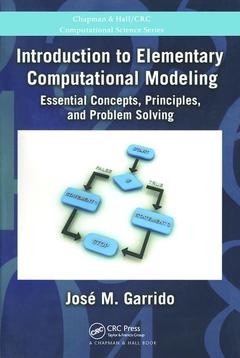Introduction to Elementary Computational Modeling Essential Concepts, Principles, and Problem Solving Chapman & Hall/CRC Computational Science Series
Auteur : Garrido Jose

With an emphasis on problem solving, this book introduces the basic principles and fundamental concepts of computational modeling. It emphasizes reasoning and conceptualizing problems, the elementary mathematical modeling, and the implementation using computing concepts and principles. Examples are included that demonstrate the computation and visualization of the implemented models.
The author provides case studies, along with an overview of computational models and their development. The first part of the text presents the basic concepts of models and techniques for designing and implementing problem solutions. It applies standard pseudo-code constructs and flowcharts for designing models. The second part covers model implementation with basic programming constructs using MATLAB, Octave, and FreeMat.
Aimed at beginning students in computer science, mathematics, statistics, and engineering, Introduction to Elementary Computational Modeling: Essential Concepts, Principles, and Problem Solving focuses on fundamentals, helping the next generation of scientists and engineers hone their problem solving skills.
Jose M. Garrido is Professor of Computer Science in the Department of Computer Science, Kennesaw State University, Georgia. He holds a Ph.D. from George Mason University in Fairfax, Virginia, an M.S.C.S also from George Mason University, an M.Sc. from University of London, and a B.S. in Electrical Engineering from Universidad de Oriente, Venezuela.
Dr. Garrido’s research interest is on: object-oriented modeling and simulation, multi-disciplinary computational modeling, formal specification of real-time systems, language design and processors, modeling systems performance, and software security. Dr. Garrido developed the Psim3, PsimJ, and PsimJ2 simulation packages for C++ and Java. He has recently developed the OOSimL, the Object Oriented Simulation Language (with partial support from NSF).
Dr. Garrido has published several papers in modeling and simulation, and on programming methods. He has also published six textbooks on objectoriented simulation and operating systems.
Date de parution : 11-2011
15.6x23.4 cm
Date de parution : 12-2020
15.6x23.4 cm
Thèmes d’Introduction to Elementary Computational Modeling :
Mots-clés :
Mathematical Expression; Command Prompt; Understanding Problem Solving; NUM; Computational Models; Simple Mathematical Techniques; Advanced Data Structures; General Functional Equation; Data Estimation and Empirical Modeling; Script File; Algorithms and Design Structures; Cartesian Plane; Function Polyval; Command File; Computational Thinking; Functional Equations; Point P1; Quadratic Equation; Difference Equation; Polynomial Function; Arithmetic Growth; Selection Structure; Repetition Structure; Data Item; Enter Array; Row Vector; Basic MATLAB; Type Float; Intermediate Data Points; Follow


